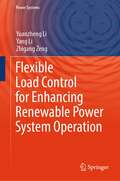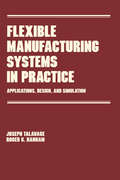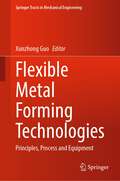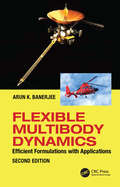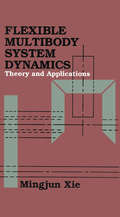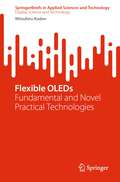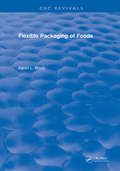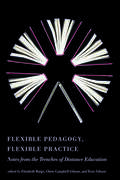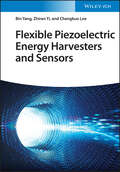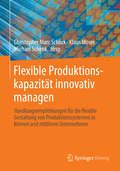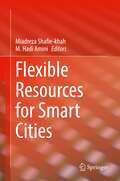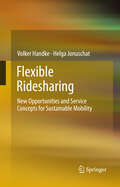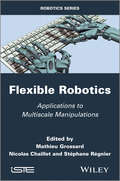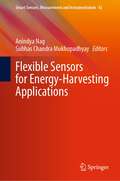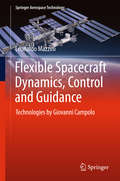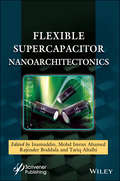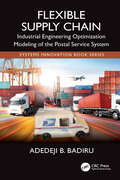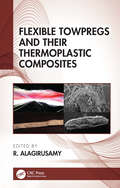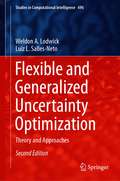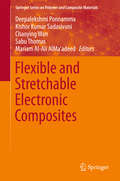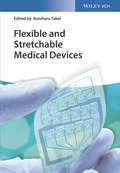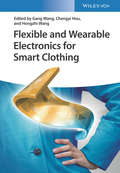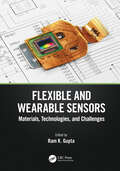- Table View
- List View
Flexible Load Control for Enhancing Renewable Power System Operation (Power Systems)
by Yang Li Zhigang Zeng Yuanzheng LiThis book addresses the pressing challenges faced by renewable power system operation (RPSO) due to the increasing penetration of renewable energy and flexible load. These challenges can be divided into two categories. Firstly, the inherent uncertainties associated with renewable energy sources pose significant difficulties in RPSO. Secondly, the presence of various types of flexible load, along with their complex constraint relationships, adds to the operational complexities. Recognizing the growing emphasis on the economic and low-carbon aspects of RPSO, this book focuses on the key issues of flexible load control. It mainly consists of following categories: (1) The control of data centers, a booming flexible load, to enhance RPSO through renewable energy integration and advanced robust multi-objective optimization. (2) The introduction of flexible industrial load control, employing effective demand-supply cooperative responding strategies for RPSO. (3) The exploration of electricvehicle flexible charging load control and centralized electric vehicle charging system control in the context of RPSO. The book also covers the emerging field of flexible integrated load control for renewable energy-based comprehensive energy system operation. Aimed at researchers, engineers, and graduate students in electrical engineering and computer science, this book provides a valuable resource for understanding and implementing flexible load control in the context of RPSO.
Flexible Manufacturing Systems in Practice: Design: Analysis and Simulation
by Joseph TalavageThis book has been written for all those interested in flexible manufacturing systems (FMS) and other forms of computerized manufacturing systems (CMS). It deals with many aspects of the design, operation, and simulation of FMS and explains the origins of FMS.
Flexible Metal Forming Technologies: Principles, Process and Equipment (Springer Tracts in Mechanical Engineering)
by Xunzhong GuoThis book systematically introduces the principles of flexible forming technologies to manufacture thin-walled complex-shaped components, the mechanism of controlling the material flow, the design and the configuration of flexible forming technologies’ equipment and tools. It covers new technologies and new processes for forming hollow components, and relevant research on forming mechanisms, deformation laws, and defect control with examples from practical applications. It will be a useful reference for researchers, engineers, graduate and undergraduate students in aerospace, nuclear, railway, vehicle and petrochemical engineering, etc.
Flexible Multibody Dynamics: Efficient Formulations and Applications
by Arun K. BanerjeeArun K. Banerjee is one of the foremost experts in the world on the subject of flexible multibody dynamics. This book describes how to build mathermatical models of multibody systems with elastic components. Examples of such systems include the human body itself, construction cranes, cares with trailers, helicopers, spacecraft deploying antennas, tethered satellites, and underwater maneuvering vehicles. This book provides methods of analysis of complex mechanical systems that can be simulated in less computer time than other methods. It equips the reader with knowledge of algorithms that provide accurate results in reduced simulation time.
Flexible Multibody Dynamics: Efficient Formulations with Applications
by Arun BanerjeeThis book demonstrates how to formulate the equations of mechanical systems. Providing methods of analysis of complex mechanical systems, the book has a clear focus on efficiency, equipping the reader with knowledge of algorithms that provide accurate results in reduced simulation time. The book uses Kane’s method due to its efficiency, and the simple resulting equations it produces in comparison to other methods and extends it with algorithms such as order-n Kane’s method compensates for the errors of premature linearization, which are often inherent within vibrations modes found in a great deal of public domain software Describing how to build mathematical models of multibody systems with elastic components, the book applies this to systems such as construction cranes, trailers, helicopters, spacecraft, tethered satellites, and underwater vehicles It also looks at topics such as vibration, rocket dynamics, simulation of beams, deflection, and matrix formulation Flexible Multibody Dynamics will be of interest to students in mechanical engineering, aerospace engineering, applied mechanics and dynamics. It will also be of interest to industry professionals in aerospace engineering, mechanical engineering and construction engineering.
Flexible Multibody System Dynamics: Theory And Applications
by Mingjun XieThis volume examines the theoretical and practical needs on the subject of multibody system dynamics with emphasis on flexible systems and engineering applications. lt focuses on developing an all purpose algorithm for the dynamic simulation of flexible tree-like systems making use of matrix representation at all levels. The book covers new theories with engineering applications involved in broad fields which include; civil engineering, aerospace and robotics, as well as general and mechanical engineering. The applications include high temperature conditions, time variant contact conditions, biosystem analysis, vibration minimization and control.
Flexible OLEDs: Fundamental and Novel Practical Technologies (SpringerBriefs in Applied Sciences and Technology)
by Mitsuhiro KodenThis book offers a wealth of knowledge and information about the fundamental and practical aspects of flexible organic light-emitting diode (OLED) devices. The book provides an overview of these devices by considering their merits and business potential, the history of their research and development, the fundamental technology, and required properties for materials, devices, processes, and future trends of flexible OLED devices. The practical sections describe novel, cutting-edge expertise for flexible substrates, gas barriers, encapsulation, novel electrodes, and on-demand patterning for OLED devices. Applications of the technologies of ultra-thin glass, stainless steel foil, and barrier films are described as flexible substrates. The book also explains features such as dry-barrier layers, wet-barrier layers, multi-layer barrier structures, dam-fill encapsulation, thin film encapsulation (TFE), and laminating encapsulation. In addition, there are explanations of novel electrodes and on-demand ink-jet patterning, both of which are applicable to flexible OLED devices. As the novel electrodes, transparent conducting polymer, silver nanowire (AgNW), metal-mesh and roll-to-roll (R2R) process technologies are included. The know-how that is described here is applicable to flexible devices, not only for OLEDs, OPVs, OTFTs, and others but also for sensors, wearable devices, robots, and healthcare devices. The information contained in this valuable book is useful for all scientists, engineers, and managers who are interested in the field of flexible devices.
Flexible Packaging Of Foods (CRC Press Revivals)
by Aaron BrodyThis review encompasses one segment of food packaging – foods. That include flexible materials in their package. It is intended as a systems view point: designing product requirements and markets, and describing the present material and machine methods for filling those requirements.
Flexible Pedagogy, Flexible Practice: Notes from the Trenches of Distance Education
by Elizabeth Burge Chère Campbell Gibson Terry GibsonFlexibility has become a watchword in modern education, but its implementation is by no means a straightforward matter. Flexible Pedagogy, Flexible Practice sheds light on the often taken-for-granted assumptions that inform daily practice and examines the institutional dynamics that help and hinder efforts toward flexibility. The collection in international in scope, drawing on the experience of specialists in distance education from North America, the United Kingdom, Australia and New Zealand, South Africa, Singapore, and Japan. Contributors to the volume were asked to reflect candidly and critically on a series of questions, including: What precisely is flexible learning? Who or what is driving the flexibility agenda, and for whose benefit? And who or what is resisting it? What challenges must be overcome in order to achieve flexibility, and what are some of the compromises it can entail?
Flexible Piezoelectric Energy Harvesters and Sensors
by Bin Yang Chengkuo Lee Zhiran YiFlexible Piezoelectric Energy Harvesters and Sensors A systematic and complete discussion of the latest progress in flexible piezoelectric energy harvesting and sensing technologies In Flexible Piezoelectric Energy Harvesters and Sensors, a team of distinguished researchers delivers a comprehensive exploration of the design methods, working mechanisms, microfabrication processes, and applications of flexible energy harvesters for wearable and implantable devices. The book discusses the monitoring of normal force, shear force, strain, and displacement in flexible sensors, as well as relevant artificial intelligence algorithms. Readers will also find an overview of design and research challenges facing professionals in the field, as well as a variety of perspectives on flexible energy harvesters and sensors. With an extensive focus on the use of flexible piezoelectric material technologies for medical applications, Flexible Piezoelectric Energy Harvesters and Sensors also includes: A thorough introduction to the working principles of piezoelectric devices, including discussions of flexible PEH and piezoelectric sensors Comprehensive treatments of the design of flexible piezoelectric energy harvesters, including the challenges associated with their structural design Fulsome explanations of the fabrication of flexible piezoelectric energy harvesters, including piezoelectric ceramic thin and think films In-depth treatments of cantilever piezoelectric energy harvesters, including optimized cantilever, bimorph, and optimized bimorph PEH Perfect for materials scientists, electronics engineers, and solid-state physicists, Flexible Piezoelectric Energy Harvesters and Sensors will also earn a place in the libraries of sensor developers, and surface physicists.
Flexible Produktionskapazität innovativ managen: Handlungsempfehlungen für die flexible Gestaltung von Produktionssystemen in kleinen und mittleren Unternehmen
by Christopher Marc Schlick, Klaus Moser and Michael SchenkDer flexible Einsatz von Mitarbeitern/-innen in produzierenden Unternehmen adressiert ein Thema von hoher wirtschaftlicher Bedeutung und Aktualität. Gestaltungsmöglichkeiten werden im Hinblick auf Produktionssysteme wie auch in Bezug auf den Einsatz der Personalressourcen behandelt. Produktionsplaner und Personalleitung erhalten konkrete Handlungsempfehlungen.Dieser praxisorientierte Handlungsleitfaden spricht insbesondere kleine und mittelständische Unternehmen an. "FlexPro - Flexible Produktionskapazität innovativ managen" war ein Forschungsprojekt in Unternehmen, dessen Ergebnisse als Grundlage dieses Leitfadens anschaulich erläutert werden.
Flexible Resources for Smart Cities
by M. Hadi Amini Miadreza Shafie-KhahThis book paves the road for researchers from various areas of engineering working in the realm of smart cities to discuss the intersections in these areas when it comes to infrastructure and its flexibility. The authors lay out models, algorithms and frameworks related to the ‘smartness’ in the future smart cities. In particular, manufacturing firms, electric generation, transmission and distribution utilities, hardware and software computer companies, automation and control manufacturing firms, and other industries will be able to use this book to enhance their energy operations, improve their comfort and privacy, as well as to increase the benefit from the electrical system. The book pertains to researchers, professionals, and R&D in an array of industries.
Flexible Ridesharing
by Volker Handke Helga JonuschatIndividual mobility is one of the most important needs of modern society and an important link between private, public and economic life. In contrast, transport also entails severe environmental and social burdens, foiling current efforts for sustainable development. As the main source of CO2 emissions, transport is a prominent driver for climate change, and individual car traffic is responsible for nearly a third of the total energy consumption. However, we have to consider that many commuters feel indeed very dependent on their car. Here, ridesharing promises to contribute to environmental protection, while still offering individual mobility. Although ridesharing options have been discussed since many years, internet and smartphones provide completeley new opportunities to find ridesharing partners today. Thus, this book deals with current efforts on implementing flexible internet- and phone-based ridesharing services. With a main focus on the users' perspective, their demands and acceptance limits, we aim to explore success factors for non-profit, but also commercial ridesharing concepts.
Flexible Robotics: Applications to Multiscale Manipulations (Wiley-iste Ser.)
by Stéphane Régnier Nicolas Chaillet Mathieu GrossardThe objective of this book is to provide those interested in the field of flexible robotics with an overview of several scientific and technological advances in the practical field of robotic manipulation. The different chapters examine various stages that involve a number of robotic devices, particularly those designed for manipulation tasks characterized by mechanical flexibility. Chapter 1 deals with the general context surrounding the design of functionally integrated microgripping systems. Chapter 2 focuses on the dual notations of modal commandability and observability, which play a significant role in the control authority of vibratory modes that are significant for control issues. Chapter 3 presents different modeling tools that allow the simultaneous use of energy and system structuring notations. Chapter 4 discusses two sensorless methods that could be used for manipulation in confined or congested environments. Chapter 5 analyzes several appropriate approaches for responding to the specific needs required by versatile prehension tasks and dexterous manipulation. After a classification of compliant tactile sensors focusing on dexterous manipulation, Chapter 6 discusses the development of a complying triaxial force sensor based on piezoresistive technology. Chapter 7 deals with the constraints imposed by submicrometric precision in robotic manipulation. Chapter 8 presents the essential stages of the modeling, identification and analysis of control laws in the context of serial manipulator robots with flexible articulations. Chapter 9 provides an overview of models for deformable body manipulators. Finally, Chapter 10 presents a set of contributions that have been made with regard to the development of methodologies for identification and control of flexible manipulators based on experimental data. Contents 1. Design of Integrated Flexible Structures for Micromanipulation, Mathieu Grossard, Mehdi Boukallel, Stéphane Régnier and Nicolas Chaillet. 2. Flexible Structures’ Representation and Notable Properties in Control, Mathieu Grossard, Arnaud Hubert, Stéphane Régnier and Nicolas Chaillet. 3. Structured Energy Approach for the Modeling of Flexible Structures, Nandish R. Calchand, Arnaud Hubert, Yann Le Gorrec and Hector Ramirez Estay. 4. Open-Loop Control Approaches to Compliant Micromanipulators, Yassine Haddab, Vincent Chalvet and Micky Rakotondrabe. 5. Mechanical Flexibility and the Design of Versatile and Dexterous Grippers, Javier Martin Amezaga and Mathieu Grossard. 6. Flexible Tactile Sensors for Multidigital Dexterous In-hand Manipulation, Mehdi Boukallel, Hanna Yousef, Christelle Godin and Caroline Coutier. 7. Flexures for High-Precision Manipulation Robots, Reymond Clavel, Simon Henein and Murielle Richard. 8. Modeling and Motion Control of Serial Robots with Flexible Joints, Maria Makarov and Mathieu Grossard. 9. Dynamic Modeling of Deformable Manipulators, Frédéric Boyer and Ayman Belkhiri. 10. Robust Control of Robotic Manipulators with Structural Flexibilities, Houssem Halalchi, Loïc Cuvillon, Guillaume Mercère and Edouard Laroche. About the Authors Mathieu Grossard, CEA LIST, Gif-sur-Yvette, France. Nicolas Chaillet, FEMTO-ST, Besançon, France. Stéphane Régnier, ISIR, UPMC, Paris, France.
Flexible Sensors for Energy-Harvesting Applications (Smart Sensors, Measurement and Instrumentation #42)
by Subhas Chandra Mukhopadhyay Anindya NagThis book investigates the fabrication of different types of flexible sensors and their subsequent implementation for energy-harvesting applications. A range of techniques, including 3D printing, soft lithography, laser ablation, micro-contract printing, screen-printing, inkjet printing and others have been used to form the flexible sensors with varied characteristics. These sensors have been used for biomedical, environmental and healthcare applications on the basis of their performances. The quality of these flexible sensors has depended on certain types of nanomaterials that have been used to synthesize the conductive parts of the prototypes. These nanomaterials have been based on different sizes and shapes, whose quality varied on the basis of certain factors like crystallinity, shapes and sizes. One of the primary utilization of these nanotechnology-based flexible sensors has been the harvesting of energy where nano-generators and nano-harvesters have been formed to generate and store energy, respectively, on small and moderate magnitudes. Mechanical and thermal energies have been harvested on the basis of the piezoelectric, pyroelectric and triboelectric effects created by the formed prototypes. The work highlights the amalgamation of these sectors to spotlight the essence of these types of sensors and their intended application.
Flexible Spacecraft Dynamics, Control and Guidance
by Leonardo MazziniThis book is an up-to-date compendium on spacecraft attitude and orbit control (AOC) that offers a systematic and complete treatment of the subject with the aim of imparting the theoretical and practical knowledge that is required by designers, engineers, and researchers. After an introduction on the kinematics of the flexible and agile space vehicles, the modern architecture and functions of an AOC system are described and the main AOC modes reviewed with possible design solutions and examples. The dynamics of the flexible body in space are then considered using an original Lagrangian approach suitable for the control applications of large space flexible structures. Subsequent chapters address optimal control theory, attitude control methods, and orbit control applications, including the optimal orbital transfer with finite and infinite thrust. The theory is integrated with a description of current propulsion systems, with the focus especially on the new electric propulsion systems and state of the art sensors and actuators.
Flexible Supercapacitor Nanoarchitectonics
by Inamuddin Mohd Imran Ahamed Rajender Boddula Tariq AltalhiThe 21 chapters in this book presents a comprehensive overview of flexible supercapacitors using engineering nanoarchitectures mediated by functional nanomaterials and polymers as electrodes, electrolytes, and separators, etc. for advanced energy applications. The various aspects of flexible supercapacitors, including capacitor electrochemistry, evaluating parameters, operating conditions, characterization techniques, different types of electrodes, electrolytes, and flexible substrates are covered. This is probably the first book of its type which systematically describes the recent developments and progress in flexible supercapacitor technology, and will be very helpful for generating new and innovative ideas in the field of energy storage material for wearable/flexible industry applications.
Flexible Supply Chain: Industrial Engineering Optimization Modeling of the Postal Service System (Systems Innovation Book Series)
by Adedeji B. BadiruCommunication is the glue that binds the diverse elements of the national economy. A flexible supply chain system creates postal communication agility and adaptability to respond to the changing technologies of the modern era. This book uses a systems-based approach of the tools and techniques of Industrial Engineering applied to a new concept of flexible supply chain systems, patterned after well-known and successful flexible manufacturing systems. It focuses on how Industrial Engineering can be used to achieve flexibility, resiliency, and efficiency in response to the needs of the global postal system.Flexible Supply Chain: Industrial Engineering Optimization Modeling of the Postal Service System provides an understanding of the techniques of using flexibility to improve operations. It capitalizes on a framework of Industrial Engineering and focuses on a global chain of non-commodity products and services. By using flexibility as the foundation for efficiency, it ties in with the digital revolution of communication and retains an affiliation with community involvement. The book uses the DEJI Systems Model and the Triple C Model as a structure of system productivity and creates a template through which other supply chains can be improved. The global supply chain is presently stressed and in need of new ideas and operational strategies.This book is an ideal read for engineers working in manufacturing production, civil, mechanical, and other industries. It will be of interest to engineering managers and consultants as well as those involved with business management. University students and instructors will also find this book useful.
Flexible Towpregs and Their Thermoplastic Composites
by R. AlagirusamyThermoplastic matrix composites have attracted much attention in the composites industry due to their easy processibility and improved impact properties. Although there are many books on thermoplastic composites available, none emphasize flexible towpregs and their composite properties. This book discusses various methods of manufacturing flexible towpregs, their properties, their textile preforming behavior, the properties of textile preform, and the properties of final composites. FEATURES Gives readers a complete view of composite manufacturing Offers details on flexible prepregs that other books overlook, such as manufacturing methods, influence of processing parameters, and properties Includes explanations that cover all steps of manufacturing with examples Features case studies and homework exercises for all chapters to reinforce understanding Provides technological information, discussion, and analysis of problems related to all types of flexible towpregs, such as commingling, electrostatic powder coating, wrapped hybrid yarns, micro-braided hybrid yarns, core-spun hybrid yarns, and others This book is aimed at readers working with composite materials, industrial textiles, and related areas to understand the significance of thermoplastic composites made through textile performance of flexible towpregs.
Flexible and Generalized Uncertainty Optimization: Theory and Approaches (Studies in Computational Intelligence #696)
by Weldon A. Lodwick Luiz L. Salles-NetoThis book presents the theory and methods of flexible and generalized uncertainty optimization. Particularly, it describes the theory of generalized uncertainty in the context of optimization modeling. The book starts with an overview of flexible and generalized uncertainty optimization. It covers uncertainties that are both associated with lack of information and are more general than stochastic theory, where well-defined distributions are assumed. Starting from families of distributions that are enclosed by upper and lower functions, the book presents construction methods for obtaining flexible and generalized uncertainty input data that can be used in a flexible and generalized uncertainty optimization model. It then describes the development of the associated optimization model in detail. Written for graduate students and professionals in the broad field of optimization and operations research, this second edition has been revised and extended to include more worked examples and a section on interval multi-objective mini-max regret theory along with its solution method.
Flexible and Stretchable Electronic Composites
by Sabu Thomas Deepalekshmi Ponnamma Mariam Al-Ali AlMa'adeed Kishor Kumar Sadasivuni Chaoying WanThis book is the first comprehensive collection of electronic aspects of different kinds of elastomer composites, including combinations of synthetic, natural and thermoplastic elastomers with different conducting fillers like metal nanoparticles, carbon nanotubes, or graphenes, and many more. It covers elastomer composites, which are useful in electronic applications, including chemical and physical as well as material science aspects. The presented elastomer composites have great potential for solving emerging new material application requirements, for example as flexible and wearable electronics. The book is structured and organized by the rubber/elastomer type: each chapter describes a different elastomer matrix and its composites. While introducing to important fundamentals, it is application-oriented, discussing the current issues and challenges in the field of elastomer composites. This book will thus appeal to researchers and scientists, to engineers and technologists, but also to graduate students, working on elastomer composites, or on electronics engineering with the composites, providing the readers with a sound introduction to the field and solutions to both fundamental and applied problems.
Flexible and Stretchable Medical Devices
by Kuniharu TakeiThe book introduces flexible and stretchable wearable electronic systems and covers in detail the technologies and materials required for healthcare and medical applications. A team of excellent authors gives an overview of currently available flexible devices and thoroughly describes their physical mechanisms that enable sensing human conditions. In dedicated chapters, crucial components needed to realize flexible and wearable devices are discussed which include transistors and sensors and deal with memory, data handling and display. Additionally, suitable power sources based on photovoltaics, thermoelectric energy and supercapacitors are reviewed. A special chapter treats implantable flexible sensors for neural recording. The book editor concludes with a perspective on this rapidly developing field which is expected to have a great impact on healthcare in the 21st century.
Flexible and Stretchable Triboelectric Nanogenerator Devices: Toward Self-powered Systems
by Mengdi Han Xiaosheng Zhang Haixia ZhangThe book starts with the fundamentals of triboelectric nanogenerators (TENGs), and continues through to fabrication technologies to achieve flexible and stretchable. Then self-powered flexible microsystems are introduced and application examples are presented, including TENG-based active sensors, TENG-powered actuators, artificial intelligence and integrated systems.
Flexible and Wearable Electronics for Smart Clothing
by Gang WangProvides the state-of-the-art on wearable technology for smart clothing The book gives a coherent overview of recent development on flexible electronics for smart clothing with emphasis on wearability and durability of the materials and devices. It offers detailed information on the basic functional components of the flexible and wearable electronics including sensing, systems-on-a-chip, interacting, and energy, as well as the integrating and connecting of electronics into textile form. It also provides insights into the compatibility and integration of functional materials, electronics, and the clothing technology. Flexible and Wearable Electronics for Smart Clothing offers comprehensive coverage of the technology in four parts. The first part discusses wearable organic nano-sensors, stimuli-responsive electronic skins, and flexible thermoelectrics and thermoelectric textiles. The next part examines textile triboelectric nanogenerators for energy harvesting, flexible and wearable solar cells and supercapacitors, and flexible and wearable lithium-ion batteries. Thermal and humid management for next-generation textiles, functionalization of fiber materials for washable smart wearable textiles, and flexible microfluidics for wearable electronics are covered in the next section. The last part introduces readers to piezoelectric materials and devices based flexible bio-integrated electronics, printed electronics for smart clothes, and the materials and processes for stretchable and wearable e-textile devices. -Presents the most recent developments in wearable technology such as wearable nanosensors, logic circuit, artificial intelligence, energy harvesting, and wireless communication -Covers the flexible and wearable electronics as essential functional components for smart clothing from sensing, systems-on-a-chip, interacting, energy to the integrating and connecting of electronics -Of high interest to a large and interdisciplinary target group, including materials scientists, textile chemists, and electronic engineers in academia and industry Flexible and Wearable Electronics for Smart Clothing will appeal to materials scientists, textile industry professionals, textile engineers, electronics engineers, and sensor developers.
Flexible and Wearable Sensors: Materials, Technologies, and Challenges
by Ram K. GuptaWith rapid technological developments and lifestyle advancements, electronic sensors are being seamlessly integrated into many devices. This comprehensive handbook explores current, state-of-the-art developments in flexible and wearable sensor technology and its future challenges. Numerous recent efforts have improved the sensing capability and functionality of flexible and wearable sensors. However, there are still many challenges in making them super-smart by incorporating features such as self-power, self-healing, and multifunctionality. These features can be developed with the use of multifunctional nanostructured materials, unique architectural designs, and other advanced technologies. This book provides details about the recent advancements, materials, and technologies used for flexible and wearable sensors. Its wide range of topics addresses the fundamentals of flexible and wearable sensors, their working principles, and their advanced applications. This handbook provides new directions to scientists, researchers, and students to better understand the principles, technologies, and applications of sensors in healthcare, energy, and the environment.
